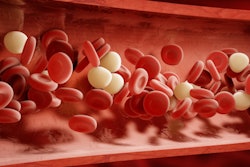
VIENNA - Because many patients presenting to the emergency department (ED) with chest pain wind up receiving follow-up testing for coronary artery disease (CAD) anyway, it's worth it to perform the "one-stop shop" of triple rule-out CT, Swiss researchers reported at ECR 2016.
A team from the University of Zurich found that nearly one-third of chest pain patients who had received dual rule-out CT for pulmonary embolism (PE) and acute aortic syndrome (AAS) wound up undergoing additional testing for CAD within one month. What's more, most of those cases had negative results for CAD. The triple rule-out protocol, which would also enable exclusion of CAD, could have obviated the need for later CAD testing in those patients, according to the group.
"Thus, evaluating patients for CAD routinely in cases of simultaneous testing for PE and AAS is feasible and could have reduced additional downstream testing," said presenter Dr. Fabian Morsbach. He shared the research during a scientific session on Thursday morning.
A common challenge
Patients who present to the emergency department with chest pain constitute a common and important diagnostic challenge; PE, AAS, and CAD are among the clinically relevant causes for chest pain that need to be differentiated.
CT exams are frequently used to exclude PE and AAS -- and increasingly CAD. The triple rule-out CT in patients serves as a "one-stop shop" for chest pain, aiming to simultaneously exclude PE, AAS, and CAD, Morsbach said.
Because the CT protocols for simultaneous evaluation of PE and AAS and the triple rule-out protocol are usually interchangeable (involving an electrocardiogram-gated CT with contrast), it's definitely possible to simultaneously rule out CAD while evaluating for PE and AAS, Morsbach said.
The researchers set out to evaluate how often patients received further testing for CAD after initially receiving a chest CT for simultaneous evaluation of the aorta and pulmonary artery in the ED. In a retrospective study conducted over a three-year period, they included all patients who had received CT for chest pain to simultaneously rule out two or more of AAS, PE, or CAD in the ED at their maximum-care academic medical center. The researchers then used a one-month follow-up period to determine if the patient had received additional testing for CAD.
All patients received a contrast-enhanced chest CT with either retrospective or prospective gating on either a first- or second-generation dual-source CT scanner (Siemens Healthcare). They were given a 100-mL iodinated contrast-media injection at 4 mL/sec. Of the 262 patients who received CT within 24 hours after admission to the ED, 106 (40%) had received either CT testing for dual rule-out of PE and CAD or triple rule-out CT. The remaining 157 (60%) underwent CT testing for dual rule-out of PE and AAS. That patient group had a mean age of 60 and 30% were female, according to Morsbach.
Further CAD testing
Of the 157 who received the dual rule-out testing for PE and AAS, 109 (69%) had no further testing for CAD. However, 48 (31%) did receive further testing for CAD after CT.
All 48 underwent another round of serological biomarker testing and 25 (52%) also underwent coronary catheter angiography. Six (13%) were given myocardial SPECT/CT exams, while an additional six (13%) had a cardiac MRI.
Coronary catheter angiography was negative for relevant stenosis in 15 (60%) of the 25 patients who received it, while the myocardial SPECT/CT exams were negative in four (67%) of the cases. In addition, cardiac MRI was negative for ischemia in three (50%) of the cases.
"We believe those negative cases could have possibly been prevented if we had just done triple rule-out CT or looked at the coronary arteries," he said.
Ultimately, most of the patients in the study did not have PE, AAS, or CAD: There were only 12 (8%) PE cases, three (2%) AAS cases, and 10 (6%) CAD cases. The remaining 84% had other diagnoses.



















